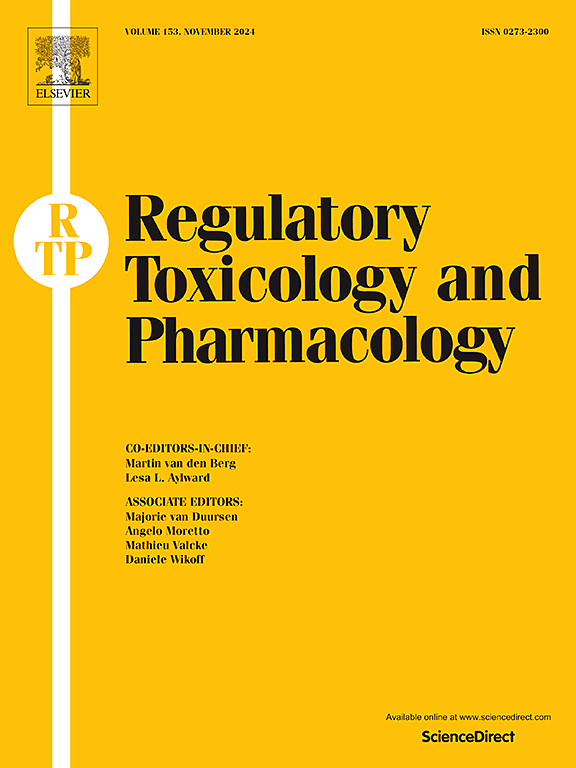Endocrine-disrupting chemicals – pesticide regulatory issues from the EU perspective
IF 3
4区 医学
Q1 MEDICINE, LEGAL
引用次数: 0
Abstract
Endocrine-disrupting chemicals (EDCs), including substances used in plant protection products (PPPs), are a source of ongoing concern for the EU society. Under the EC Regulation 1107/2009, the endocrine-disrupting (ED) properties of active substances, safeners, and synergists used in PPPs shall be investigated. The scientific criteria established by the Regulation (EU) 2018/605 and the joint guidance of the European Chemicals Agency (ECHA)/European Food Safety Authority (EFSA) provide the basis for this assessment. Data requirements for the approval of safeners and synergists have been recently published in Commission Regulation (EU) 2024/1487, allowing a consistent assessment of these substances. The approach to assessing co-formulant hazards is currently a subject of EU-wide discussion. It outlines the necessity to take into account information or evaluation data from other than pesticides' EU regulatory frameworks, such as REACH or SCCS applications for cosmetic ingredients. This paper outlines: a) current EU approach applied for identification of endocrine disrupting properties of pesticides; b) issues related to European regulations that may have an indirect impact on the safe use of plant protection products and c) an analysis of the European Commission's activities aimed to limit exposure to EDCs associated with use of PPPs in the society.
干扰内分泌的化学品--欧盟视角下的农药监管问题。
干扰内分泌的化学品(EDCs),包括植物保护产品(PPPs)中使用的物质,是欧盟社会持续关注的问题。根据欧盟委员会第 1107/2009 号法规,应调查植保产品中使用的活性物质、安全剂和增效剂的内分泌干扰(ED)特性。法规(EU)2018/605 制定的科学标准以及欧洲化学品管理局(ECHA)/欧洲食品安全局(EFSA)的联合指南为这一评估提供了依据。欧盟委员会法规(EU)2024/1487 最近公布了安全剂和增效剂审批的数据要求,以便对这些物质进行一致的评估。评估共配制剂危害的方法目前是欧盟范围内讨论的主题。它概述了考虑来自农药以外的欧盟监管框架的信息或评估数据的必要性,如 REACH 或化妆品成分的 SCCS 申请。本文概述了:a) 当前欧盟用于识别农药内分泌干扰特性的方法;b) 可能会对植物保护产品的安全使用产生间接影响的欧洲法规相关问题;c) 对欧盟委员会旨在限制社会中与使用植物保护产品相关的 EDCs 暴露的活动进行分析。
本文章由计算机程序翻译,如有差异,请以英文原文为准。
求助全文
约1分钟内获得全文
求助全文
来源期刊
CiteScore
6.70
自引率
8.80%
发文量
147
审稿时长
58 days
期刊介绍:
Regulatory Toxicology and Pharmacology publishes peer reviewed articles that involve the generation, evaluation, and interpretation of experimental animal and human data that are of direct importance and relevance for regulatory authorities with respect to toxicological and pharmacological regulations in society. All peer-reviewed articles that are published should be devoted to improve the protection of human health and environment. Reviews and discussions are welcomed that address legal and/or regulatory decisions with respect to risk assessment and management of toxicological and pharmacological compounds on a scientific basis. It addresses an international readership of scientists, risk assessors and managers, and other professionals active in the field of human and environmental health.
Types of peer-reviewed articles published:
-Original research articles of relevance for regulatory aspects covering aspects including, but not limited to:
1.Factors influencing human sensitivity
2.Exposure science related to risk assessment
3.Alternative toxicological test methods
4.Frameworks for evaluation and integration of data in regulatory evaluations
5.Harmonization across regulatory agencies
6.Read-across methods and evaluations
-Contemporary Reviews on policy related Research issues
-Letters to the Editor
-Guest Editorials (by Invitation)

 求助内容:
求助内容: 应助结果提醒方式:
应助结果提醒方式:


